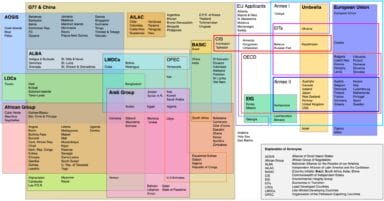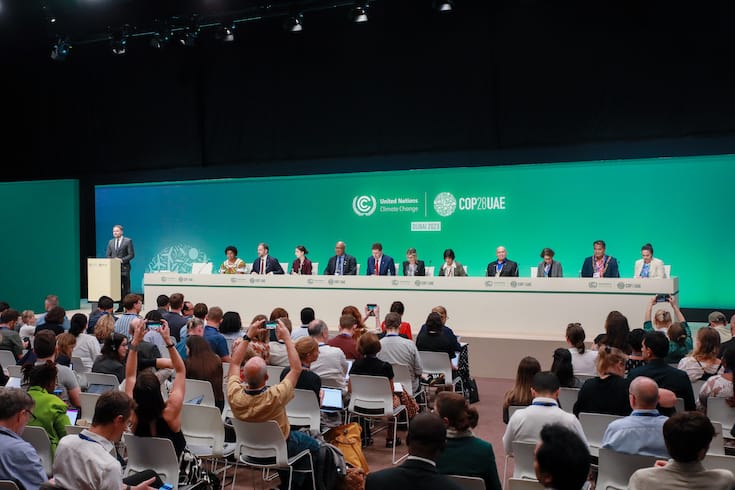Negotiating Groups
All countries send individual delegations to COP, but not all issues are negotiated individually. The Parties are distributed into several negotiating groups, with varying degrees of rigidity and independence. Some, like the EU, negotiate all issues as one, while others, like the Umbrella Group, provide loose coordination.
G77+China (135 members): Mostly composed of developing countries, this is the largest and oldest negotiating group. It’s not only a climate-negotiating group; it also represents its members in several policy and economy forums. Currently chaired by Uganda.
AGN (African Group of Negotiators) (54 Members): All countries in Africa are included in the AGN, making it the largest regional group. Currently co-chaired by Kenya and Tanzania.
Arab States (22 Members): Includes countries in North Africa and the Middle East. Members are often vulnerable to climate change, but are also fossil fuel–rich.
EIG (Environmental Integrity Group) (6 Members): Includes Mexico, South Korea, Switzerland, Liechtenstein, Monaco, and Georgia, countries which weren’t in other groups during the negotiation of the 1997 Kyoto Protocol.
EU (European Union) (27 members): EU countries always negotiate together. They meet privately, before and during COP, to establish common negotiation positions. Its members are mostly developed countries with high climate ambition, while also remaining aligned with other developed countries in key climate finance issues. Currently chaired by Hungary.
LDC (Least Developed Countries) (46 members): Countries in this group are among the most vulnerable worldwide to climate change. They consistently push for ambitious climate action, and demand strong and legally binding financial commitments from developed countries. Currently chaired by Malawi.
AOSIS (Alliance of Small Island States) (39 members): AOSIS members are Small Island Developing States (SIDS). They are typically very vulnerable to the impacts of climate change, and among the most vocal and ambitious countries at COP. Currently chaired by Samoa.
Umbrella Group (11 members): Umbrella members are mostly industrialized nations that are not part of the EU, including the US, Australia, and the UK. The group is informally structured and its members often negotiate individually.
BASIC (4 members): This is an informal group of four large emerging economies: Brazil, South Africa, India, and China.
ALBA (Bolivarian Alliances for the Peoples of our America) (10 members): Latin American and Caribbean countries with left-wing governments.
AILAC (Independent Alliance of Latin America and the Caribbean) (7 members): Other Latin American and Caribbean countries.
HAC (High Ambition Coalition) (no official member list): This group aligns countries that usually propose very progressive climate policies and push for greater ambition. Currently chaired by Marshall Islands.
Like-Minded Developing Group (LMDC) (22 members): A shifting group of developing countries that include heavyweights such as China and India. Their main role is to highlight the divide between developed and developing countries, and to push for more climate action from the former.

Acronyms
For a more expansive list of acronyms, refer to the International Institute for Sustainable Development’s glossary.
UNFCCC: United Nations Framework Convention on Climate Change
NCQG: New Collective Quantified Goal
NDCs: Nationally Determined Contributions
LULUCF: Land Use, Land-Use Change and Forestry
GST: Global Stocktake
GCF: Green Climate Fund
SIDs: Small Island States
IPCC: Intergovernmental Panel on Climate Change
Key Resources
IISD Earth Negotiations Bulletin: Technical newsletter which follows international environmental negotiations (not only COP).
ECO newsletter (CAN): COP-focused newsletter published during the Summit by the NGO Climate Action Network. Very detailed resource key to follow unofficial and non-governmental events.
GSCC Climate Diplomacy Newsletter: Published by Ed King, this newsletter, written in simple and accessible language, is an excellent resource to follow climate diplomacy developments year-long. It’s published monthly, and (almost) daily during COP.
COP28 key outcomes article (Carbon Brief): Exhaustive and comprehensive summary of the events that took place in Dubai during COP28. Rich with links, quotes, and sources, this is an essential read to get up to speed before the start of COP29.
Carbon Brief COP texts tracker (COP29 tracker hasn’t been published yet, see the COP28 tracker here): During COP, British outlet Carbon Brief follows the changes in the negotiated texts. Follow their journalists’ Twitter accounts for explainers and more information.
Climate Action Tracker country reports: CAT analyzes, updates, and rates all official climate pledges, plans, and policies made by countries. Their style is graphic and accessible. Sign up for their newsletter to keep up to speed with any new data.
WRI Resources Center: In-depth analysis from a technical global NGO with a focus on solutions and development in the Global South.
Thematic Days
14 November: Finance, Investment, and Trade
15 November: Energy, Peace, Relief, and Recovery
16 November: Science, Technology, and Innovation/Digitalization
18 November: Human Development/Children and Youth/Health/Education
19 November: Food, Water, and Agriculture
20 November: Urbanization, Transport, and Tourism
21 November: Indigenous Peoples/Gender Equality/Nature and Biodiversity/Oceans and Coastal Zones
